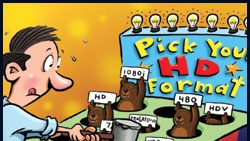Whack-a-Mole

Have you ever played the carnival game called Whack-a-Mole? It's a game where a board has about a dozen holes, and mechanical moles pop up and down. The object is to whack as many of them as possible as they pop in and out of view, within a certain time frame, for prizes. Children love it for the excitement. Adults, personally speaking, love it for the safe path it provides for expressing aggression.
I wonder if picking the right HDTV technology is similar? If you get it right and hit the target, you're successful. If you miss, you and your facility could be in a deep hole.
When it came to picking HD formats, the USA jumped early. The networks CBS and NBC quickly adopted 1080i. ABC then selected 720p, followed years later by the laggard network FOX. The result in the USA is a mishmash of formats and standards for American broadcasters and consumers.
While the European continent was slow to adopt a transmission standard, it wisely chose DVB. Today, more than 35 countries have now standardized on this flexible modulation scheme.
Europe again has the opportunity to become a world standard, this time in terms of HDTV display formats. While there was certainly a dust up at IBC2004 — where on Saturday the decision had been made to go with 720p — by Monday the decision had been unmade, and the 1080i picture format was still in the running.
However, as more televisions are based on displays that rely on native progressive imaging, a matching progressive transmission scheme seems like a plausible decision.
Such consumer moves could provide a powerful incentive for producers to create in 720p because it matches that of the home displays. No display transcoding would be needed. Sure, 1080p would provide even higher quality, but someone please explain why we should wait.
Get the TV Tech Newsletter
The professional video industry's #1 source for news, trends and product and tech information. Sign up below.
Of course, that means the titans of broadcast equipment, Panasonic and Sony, will continue to battle over their favorite formats — not so much for what may be the technical superior format, but more for the corporate imaging and marketing claims they've staked out. For consumers like you and me, this is good because competition always brings innovation — and lower prices.
Unfortunately, one might view such esoteric technical battles as mere posturing, if the decisions weren't so expensive. No engineer or technical manager wants to make a mistake of choosing the wrong tools for his facility.
Years ago, there was a phrase, “No one ever got fired for buying IBM.” That meant buying IBM equipment was a safe purchase. The results might have not been the most innovative, but then you knew the solution would work, and you wouldn't get fired.
Such a purchase decision philosophy is no longer appropriate. Maybe no one ever got fired for buying brand S or P or T, but then maybe their facilities didn't get the best solution at the lowest price either.
Picking the right tool is always a moving target; when you've figured out the best solution, something better comes along. Should you wait? No! Go ahead, and whack that mole.
Send comments to: • editor@primediabusiness.com • www.broadcastengineering.com
